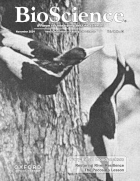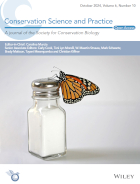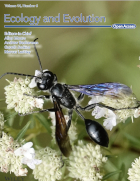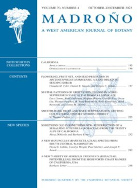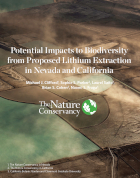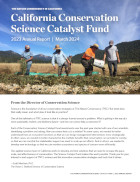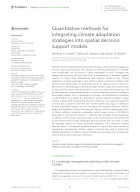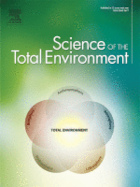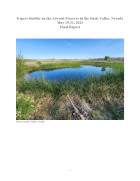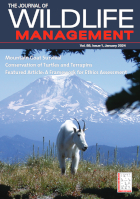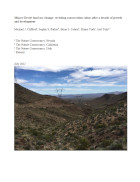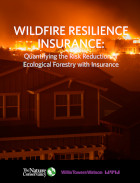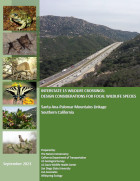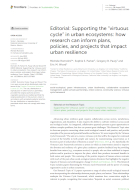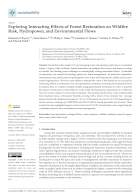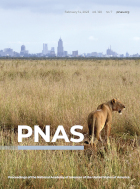Products
We identify issues and uncertainties that pose obstacles to conservation and then—in collaboration with internal and external colleagues—develop science products that help overcome those obstacles.
2025 | Terrestrial | Planning | Science | Publications & Reports
Is our climate fight killing the environment? A case for smart from the start planning
Michael J Clifford, Peter Gower, Tanya Anderson, Jaina Moan, Mickey Hazelwood, Sophie S Parker, Laurel Saito
Dramatic changes to the transportation and energy sectors are required to reduce greenhouse gas emissions and meet the goal of keeping global average temperatures from rising. The authors discuss how…2025 | Terrestrial | Science | Publications & Reports
Oren Pollak Memorial Research Fund - 2025 RFP
The Oren Pollak Memorial Research Fund was established in 2000 in memory of Dr. Oren Pollak, a leading grassland ecologist and restoration pioneer, as well as an ardent champion and mentor for…2024 | Terrestrial | Planning | Science | Publications & Reports
An approach to designing efficient implementation of 30×30 terrestrial conservation commitments
Carrie A. Schloss, D. Richard Cameron, Bradley Franklin, Christoph Nolte, Scott A. Morrison
In response to biodiversity declines worldwide, over 190 nations committed to protect 30% of their lands and waters by 2030 . As these jurisdictions move from planning to implementation, we propose a…2024 | Terrestrial | Planning | Science | Publications & Reports
Climatically robust multiscale species distribution models to support pronghorn recovery in California
William T. Bean, H. Scott Butterfield, Jeanette K. Howard, Thomas J. Batter
In this paper, the authors used a variety of habitat suitability modeling approaches to begin to understand where pronghorn may exist in the future in California under different climate change…2024 | Terrestrial | Marine | Science | Publications & Reports
Spatial Patterns of Vegetation Change in a Fire-Suppressed Coastal California Landscape
Lucy Genua, Brad Anderson, Meghan Bowen, Genelle Ives, Owen Liu, Thomas Paschos, H. Scott Butterfield, Kelly Easterday, Mark Reynolds, James H. Thorne
In this paper, the authors used historical vegetation data, from both aerial photographs and field transects, to assess the change in major vegetation types at the Dangermond Preserve over the last…2024 | Freshwater | Terrestrial | Science | Publications & Reports
Potential Impacts to Biodiversity from Proposed Lithium Extraction in Nevada and California
Michael J. Clifford, Sophie S. Parker, Laurel Saito, Brian S. Cohen, Naomi S. Fraga
Lithium batteries are important for the clean energy transition in the United States because they are used in electric vehicles and for grid power storage. However, lithium extraction may have impacts…2024 | Freshwater | Terrestrial | Marine | Science | Publications & Reports
Conservation Science Catalyst Fund - 2023 Annual Report
The Nature Conservancy deploys science to help overcome major challenges facing people and nature. In today’s fast-paced world, turning threats to nature into opportunities for conservation…2024 | Terrestrial | Planning | Science | Publications & Reports
Quantitative methods for integrating climate adaptation strategies into spatial decision support models
Nicholas A. Povak, Patricia N. Manley, Kristen N. Wilson
This study presents a methodology to integrate spatial assessments of current and future forest conditions to understand the potential to achieve desired conditions under climate change with ongoing…2024 | Freshwater | Terrestrial | Publications & Reports
Potential impacts of proposed lithium extraction on biodiversity and conservation in the contiguous United States
Sophie S. Parker, Michael J. Clifford, Brian S. Cohen
To address climate change, the United States is incentivizing the production of electric vehicles containing domestically derived lithium batteries. Extracting this lithium may have environmental…2024 | Terrestrial | Science | Publications & Reports
Oren Pollak Memorial Research Fund - 2024 RFP
The Oren Pollak Memorial Research Fund was established in 2000 in memory of Dr. Oren Pollak, a leading grassland ecologist and restoration pioneer, as well as an ardent champion and mentor for…2024 | Freshwater | Terrestrial | Publications & Reports
Expert bioblitz on the Atwood Preserve
Michael Clifford, Sophie Parker, Matt Rader, Lydia Bailey, Naomi Fraga, Chris Hass, Estella Hernandez, Jan Kempf, Lois Merkler, Michael Swink
The Amargosa River supports one of the most outstanding suites of endemic and imperiled species in the world. In 2019, TNC acquired the Atwood Preserve in the river’s headwaters, the…2023 | Terrestrial | Planning | Science | Publications & Reports
Contrasting management paradigms for pronghorn in the arid Southwest and their northern range: a review
William T. Bean, H. Scott Butterfield, Craig Fiehler, David Hacker, Jeanette K. Howard, Russell Namitz, Brandon Swanson, Thomas J. Batter
TNC launched a Water for Wildlife project motivated by understanding the importance of standing free water across the season for wildlife in general, but most importantly for those species sensitive…2023 | Terrestrial | Science | Publications & Reports
Mojave Desert land-use change: revisiting conservation values after a decade of growth and development
Michael J. Clifford, Sophie S. Parker, Brian S. Cohen, Elaine York, Joel Tuhy
This paper provides an assessment of changes in the conservation value of lands in the Mojave Desert of Nevada and Utah resulting from renewable energy and other development between 2010 and 2018. The…2023 | Terrestrial | Economics | Publications & Reports
Wildfire Resilience Insurance: Quantifying the Risk Reduction of Ecological Forestry with Insurance
The Nature Conservancy with Willis Towers Watson, Sarah Heard
California has the highest wildfire risk in the US, and climate change will continue to exacerbate the risk, at least in the foreseeable future. As a result, California is facing an insurance crisis,…2023 | Terrestrial | Planning | Science | Publications & Reports
Interstate 15 Wildlife Crossing Design Considerations for Focal Wildlife Species. Santa Ana-Palomar Mountains Linkage Southern California
Trish Smith, Cheryl Brehme, Jill Carpenter, Nancy Frost, Megan Jennings, Barbara Kus, Scott Quinnell, Spring Strahm, T. Winston Vickers
The Nature Conservancy and the California Department of Transportation are planning 3 wildlife crossing infrastructure projects along a 3-mile stretch of Interstate 15 (I-15) in the Santa Ana-Palomar…2023 | Freshwater | Terrestrial | Science | Publications & Reports
Statistical evaluation of the similarity of characteristics in springs of the California Desert, United States
Adam H. Love, Andy Zdon, Naomi S. Fraga, Brian Cohen, Maura Palacios Mejia, Rachel Maxwell, Sophie Parker
This paper presents results from the Mojave Desert Springs research project. The authors present a comprehensive statistical analysis of similarities between California desert springs. An observed…2023 | Terrestrial | Science | Publications & Reports
Supporting the “virtuous cycle” in urban ecosystems: how research can inform plans, policies, and projects that impact urban resilience
Michele Romolini, Sophie S. Parker, Gregory B. Pauly, Eric M. Wood
This editorial introduces a group of 11 articles published as part of an organized research topic in the Urban Greening section of the journal Frontiers in Sustainable Cities. In contrast with the…2023 | Terrestrial | Planning | Science | Publications & Reports
Exploring interacting effects of forest restoration on wildfire risk, hydropower, and environmental flows
Benjamin P. Bryant, Tessa Maurer, Phillip C. Saksa, John D. Herman, Kristen N. Wilson, Edward Smith
The authors of this study analyzed how wildfires and forest restoration, specifically thinning and prescribed fire being implemented in the French Meadows Project in the central Sierra Nevada, could…2023 | Freshwater | Terrestrial | Planning | Science | Publications & Reports
A resilient and connected network of sites to sustain biodiversity under a changing climate
Mark G. Anderson, Melissa Clark, Arlene P. Olivero, and D. Richard Cameron
In response to biodiversity loss, scientists have called for the protection of well-connected systems of protected areas covering 30 to 50% of the planet. However, as climate change drives shifts in…
